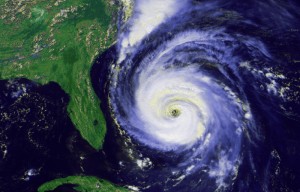Wind and water can have a devastating impact on property. Yet, as Hurricane Sandy made it clear in 2012, separate insurance systems for wind and flood damage make the task of sorting out the damage caused by a storm a highly cumbersome process.
Building on the success of the existing Florida Public Hurricane Loss Model and supported by an initial grant of $1.5 million from the state of Florida, a team of highly-qualified experts in meteorology, engineering, coastal science and hydrology, computer science, statistics, actuarial sciences, insurance and finance have embarked on the first public effort to bring wind, storm surge, and rain flood under one cohesive umbrella.
“At FIU we pride ourselves in being a solutions center for our community,” said FIU President Mark B. Rosenberg. “Through this work, we will impact homeowners and business owners not just in our state but potentially around the country.”
FIU professors lead the team that includes specialists from the University of Florida, Florida State University, Florida Institute of Technology, Hurricane Research Division of NOAA’s Atlantic Oceanographic and Meteorological Laboratory and University of Miami. These experts and the project will make Florida and the State University System leaders in innovative hurricane risk and loss research and will continue to benefit the state and country for decades.
“We have amassed a tremendous amount of expertise over the past 10 years at FIU,” said Shahid Hamid, who leads the Florida Public Loss Model project and is a professor in the College of Business and the director of Laboratory for Insurance, Financial, and Economic Research at the International Hurricane Research Center at FIU.

The model has been used about 600 times by the state and by private companies to evaluate windstorm rates for personal residential properties. The Florida Public Loss Model is the state’s only certified and transparent method of determining annual expected insured and probable maximum losses as a result of hurricanes and helping to determine windstorm rates. All other existing models are “black box” models owned by private companies.
“Now we are going to integrate storm surge and rain flood risk with the wind risk and estimate both the insured and uninsured losses they may create. The result will be a scientifically-sound predictor of what kinds of damages a storm will cause in a given geographic area given the types of buildings and many other factors,” said Shu-Ching Chen, professor in the School of Computing and Information Sciences at FIU and co-director of the project.
At the end of the three-year project, Florida will have a non-proprietary, integrated wind field/storm surge/flood model that can distinguish wind losses from flood losses.
“The benefit to the people of the state of a public flood model is that they can be confident that if a premium is charged to them there is transparency in how that was developed,” said Howard Eaglefeld, actuary with the Florida Office of Insurance Regulations. “This is a state-funded model and therefore it will be transparent.”
